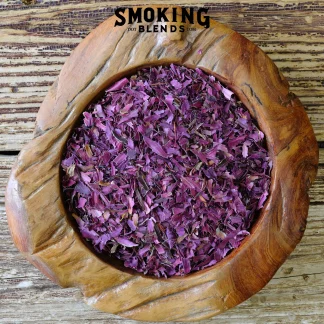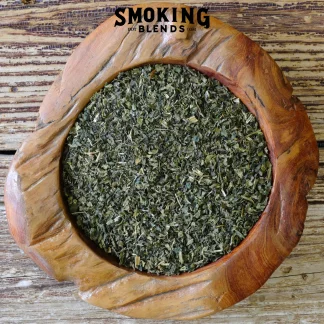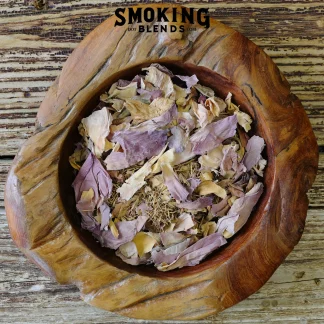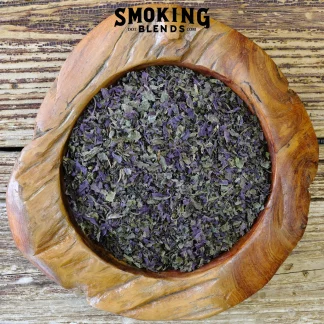Description
This wildcrafted perilla leaf is received by us whole. They are quite large and have large, woody stems attached to them. We process the whole perilla leaf, removing the stems and larger veins of the leaf, creating a clean material with a uniform size, perfect for tea, blending or smoking. Enjoy!
Perilla leaf, scientifically known as Perilla Fruitescens Folium, is an annual plant native to Southeast Asia and widely cultivated in China, Japan, Korea, Thailand, and other Asian countries. The plant belongs to the mint family, Lamiaceae, and has been used for culinary, medicinal, and ornamental purposes for centuries. Perilla was introduced to Europe as an ornamental plant for gardens in the 19th century. With the rise of interest in diverse cuisines and healthy eating habits, perilla leaves have gained popularity in Western countries.
Botanical name: Perilla Fruitescens
Plant family: Lamiaceae
Also called: Beefsteak Plant, Shiso and Wild Coleus.
Ancient Cultivation and Traditional Use:
Perilla has a long history of cultivation in China, dating back to around 2,000 years ago. Chinese traditional medicine utilized perilla seeds and leaves for their medicinal properties. Perilla was introduced to Japan around the 8th century. In Japanese cuisine, perilla leaves are known as “shiso.” There are two main varieties: green (aojiso) and red (akajiso). Green perilla is commonly used in sushi dishes, while red perilla is often pickled for later use. The leaves have been a staple in Korean cuisine for centuries. They are used as a wrap for meats and vegetables and are a key ingredient in dishes like kkaennip kimchi, a type of traditional Korean kimchi. Perilla is also cultivated and used in various dishes in countries like Thailand and Vietnam. In these regions, it’s often used in salads, soups, and stir-fry dishes.
Benefits of Perilla
In Chinese traditional medicine, perilla leaves are believed to have various medicinal properties, including promoting lung health and alleviating symptoms like cough and asthma. The seeds are also used for their oil, which is rich in omega-3 fatty acids. In Ayurvedic medicine, perilla seeds and leaves are used for their potential health benefits. The oil extracted from perilla seeds is used in Ayurvedic practices. Perilla leaves are rich in nutrients, including vitamins A and C, calcium, and iron. They are also a good source of antioxidants. Perilla leaves are widely used in Asian cuisine for their aromatic flavor. They are used in salads, sushi, soups, and various other dishes. Modern research has focused on the potential health benefits of perilla, including its anti-inflammatory, antioxidant, and antimicrobial properties. Studies have explored perilla extracts’ potential for treating conditions like allergies and asthma.
Identification
Identifying perilla (Perilla frutescens) involves examining various aspects of the plant, including its leaves, stems, flowers, and overall growth habit. Perilla has several varieties, including green and red (purple) perilla, and they may exhibit slight variations in appearance. Here’s a guide to help you identify perilla:
Perilla is an annual herb, which means it completes its life cycle in one year. It typically grows to a height of about 1 to 2 feet (30 to 60 cm). It is a bushy plant with multiple branches.
Perilla leaves are the most distinctive feature. They are typically broad, serrated, and have a unique, wrinkled texture. They are usually opposite, meaning they grow in pairs directly across from each other on the stem. Green perilla leaves are typically green, while red (purple) perilla leaves have a reddish-purple hue on the underside with green or purple on top. The leaves emit a strong, aromatic fragrance when crushed. The aroma can vary between green and red perilla.
Perilla produces small, tubular flowers that are typically white, pink, or purple, depending on the variety. The flowers are arranged in spikes on the terminal ends of the stems. Perilla plants produce small, oval-shaped brown or black seeds.
Perilla stems are usually square-shaped, which is a characteristic feature of the mint family (Lamiaceae) to which perilla belongs. The stems may be green or slightly reddish, especially in the red (purple) perilla variety.
Habitat
Perilla is commonly cultivated in Asia and other regions with a similar climate. It thrives in well-drained soil and prefers full sun or partial shade.
It’s important to note that there are several varieties and cultivars of perilla, so there may be some variations in leaf shape, color, and size. Additionally, perilla can sometimes be confused with other plants in the mint family due to the square stems, so it’s a good practice to verify the leaf characteristics, especially the aroma, to ensure correct identification.
If you plan to consume perilla from the wild, be absolutely certain about its identification, as some plants can be toxic.
Uses
Perilla Leaf Tea
Perilla leaf tea, often made from the leaves of the Perilla frutescens plant, is a popular herbal beverage in various Asian countries, including China, Japan, Korea, and Vietnam. The tea is known for its unique flavor, which is a combination of minty, basil-like, and grassy notes with a hint of spiciness. Perilla leaf tea is not only enjoyed for its taste but also valued for its potential health benefits.
How to Make Perilla Tea
Try starting out with 1 gram of perilla leaf per 16 oz of water. Slowly boil the leaf in the water for at least 5 minutes, allow it to cool, and strain out the remaining material. If you would like a stronger or weaker tea, you can increase or decrease the amount of leaf used and the amount of time it is boiled in small increments.
Smoking Perilla Leaf
Unlike its relative, field mint, perilla leaf has a much softer but unique flavor when smoked. The smoke is somewhat smooth, and the leaf can be smoked in any smoking instrument, including dry herb vaporizers. This herb is not traditionally smoked or used in herbal smoking blends. However, like many other herbs that have not been used previously for smoking, we do utilize this herb leaf in some of our blends. We prefer to innovate rather than imitate.
Perilla Leaf Smudge
There is no established tradition or historical background for using perilla leaves specifically in smudging rituals. However, for people who enjoy smudge strictly for incense purposes, this herbs unique smoke may be a welcomed addition to their smudging ingredients.
Perilla in Herbal Supplementation
Perilla (Perilla Frutescens) has been used for centuries in traditional medicine systems, particularly in Asian cultures, for its potential health benefits. In modern times, perilla supplements are derived from the leaves, seeds, or oil of the plant. When choosing perilla supplements, opt for reputable brands that adhere to quality standards. Look for third-party certifications that ensure the product’s purity and quality.
This material is meticulously processed and cleaned by hand. Please have a look on our Hand Processing Herbs Page for more information.
Perilla leaf has a rich history deeply rooted in Asian cultures, where it has been used both for its culinary delights and medicinal properties. Its journey from ancient medicinal practices to modern kitchens showcases its diverse applications and enduring popularity.






Reviews
There are no reviews yet.